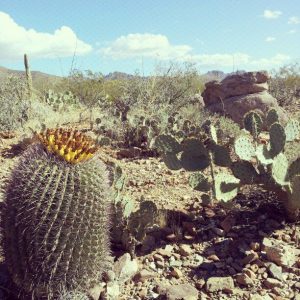Conserving the Desert – A Landscape of Politics and Beauty

By Jose Gonzalez, NewsTaco
Imagine the desert—what comes to mind?
The desert can easily lead to stereotypes: dry, hot, uninhabitable, barren and full of sand. But for those that have experienced and know the range of the desert ecosystem in the US Southwest and Northern Mexico, the desert is more complex than simple stereotypes.
For Latinos, it is fair to note that in the context of immigration, the desert can be a place of death for many immigrants, a place cut by a steel wall demarcating a border with so many other connotations, a place of politics.
But Latinos have a deeper history with the desert, reaching back to the use of acequias from Spanish times—a system now seen through eco-sustainability lens as a way to not only sustain an agricultural lifestyle, but also to care for and sustain the Earth and its natural creatures.
Looking at the present and future, Latinos can continue to lend their voice, and historical experience, to the conservation of such a beautiful ecosystem.
The desert can certainly seem a paradoxical landscape with extreme temperatures and varying weather. But the desert can host verdant ecosystems and thriving forest of saguaros and Joshua trees. Countless species adapted to adversity thrive in their ecological niches. Histories of man and nature are etched in the cliffs and rocks—centuries woven throughout the whole landscape.
But all of this is fragile. Saguaros are like oaks and redwoods, living for hundreds of years but easily felled. Topsoil and archeological sites are easily disrupted or destroyed by off-roading recreation. Like in many other ecosystems, it is easier to destroy, but in the desert it can take longer to recover.
Part of the challenge in conserving the desert may come from a though that the desert is “nothing”—that we are improving a barren landscape—it is easier to imagine “developing” a desert plot than cutting down a deciduous or evergreen grove for subdivisions.
This is not meant to simply generalize—there are certainly many individuals and organizations working to conserve the desert, highlight its beauty, and point out Latino connections. Polling also points to Hispanos supporting public land conservation in Southwest landscapes.
This matters because the desert will continue to be a place of tension between conservation and development, most recently highlighted by the development of solar projects. This has been news because it pits two conservation issues against each other: what makes sense from a renewable energy perspective may be put into conflict to conserve endangered species.
If you have never been to the desert and lost yourself in the landscape, observed a sunset and let its poetry run through your mind, it is worth taking the trip. And if you need a place to start in understanding the ecology of it, places such as the Arizona-Sonora Desert Museum in Tucson, Arizona, provide a great opportunity to immerse yourself in the flora and fauna through bilingual signage.
So apart from being one of the stages in the immigration debate, the desert deserves a look in its own right—as a place of ecological beauty and necessity, a place to conserve.
[Photo by Jose Gonzalez]

